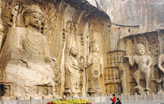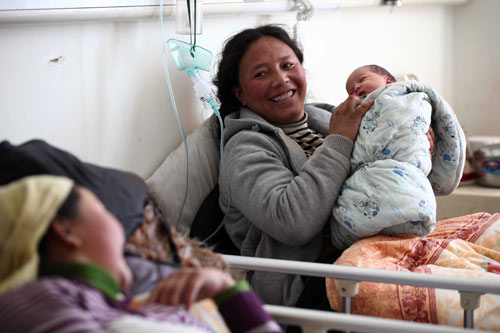China
Tibetans choosing hospitals for childbirth
Updated: 2011-03-29 07:53
By Wang Yan (China Daily)
|
|
LHASA - Tsering Chozom, 31, is all smiles since she gave birth to her second child at the Lhasa People's Hospital in the capital of the Tibet autonomous region.
Accompanied by her husband, Tashi Tsering, Tsering Chozom traveled about 1,000 kilometers from her hometown in Nagqu county to Lhasa for the delivery.
She gave birth on March 15 with little trouble, even though doctors had worried that her baby boy might be in danger because of his awkward position in the womb and that of his umbilical cord around his neck.
The medical care given to pregnant women has improved by leaps and bounds in the autonomous region in recent years, largely because of policies that encourage women to give birth in hospitals and an influx of public and private money that helps to pay for the necessary medical care, according to Phurbu Drolma, director of the Tibet health department.
"Compared with 2000, the maternal mortality rate in 2010 decreased by 292.1 deaths for each 100,000 women who go into labor, and the infant mortality rate decreased by 14.59 deaths for each 1,000 births," Phurbu Drolma told China Daily.
"The percentage of (Tibetan) women who give birth in hospitals increased to 53.57 percent in 2010, which is a huge jump when compared with the 2.9 percent (who gave birth in hospitals) in 1989," she said.
In the past, Tibetan women have usually given birth in their homes, in part because trips to hospitals were not common in their culture and in part because hospitals themselves were rarely found in rural areas.
The situation has changed.
Tsering Chozom said she chose to give birth in a hospital because "it's safer and more convenient".
"Our first son is now one-and-a-half years old," she said while resting in a ward with her newborn son in her arms. "He was born at the Nagqu People's Hospital. We came to Lhasa this time because medical conditions are better here."
As she spoke, Xiong Ying, a senior nurse in the department of gynecology and obstetrics at the hospital, was busy telling the couple to avoid placing the baby in a thick cover.
"We have been seeing more and more women from farming and pasturing areas coming here for delivery," Xiong said.
"In old times, Tibetan people didn't think that giving birth was something to be concerned about. Many would just have their babies at home, which caused many women and newborns to die.
"But now, at busy times, we see as many as 11 newborns in one day. Sometimes we even have to add beds to the corridors."
Ao Dexiu, deputy director of the hospital, said health authorities encourage women from rural areas to give birth in hospitals.
"Each of the pregnant women has been given a 'green card', which ensures free medical care at any hospital in Tibet," Ao said.
"So far, central and local governments have allocated 70.56 million yuan ($10.7 million). The money from other sources has also totaled more than 30 million yuan and 1.67 million euro," Phurbu Drolma said.
By the end of 2010, Tibetan cities contained seven centers offering care to mothers and newborns, while the autonomous region's rural areas contained 51 such places, she said.
Even so, Ao said her hospital must cope with a shortage of medical personnel.
"The department of gynecology and obstetrics is the busiest in the hospital," she said. "Ideally, every 10 patients should have five or six nurses to take care of them. But we have only four nurses for every 10 patients."
China Daily
Specials

Tea-ing up
More turning to Chinese tea for investment opportunities like vintage wine

A cut above
The ancient city of Luoyang is home to a treasure trove of cultural wonders.

Rise and shine
The Chinese solar energy industry is heating up following recent setbacks in the nuclear sector

